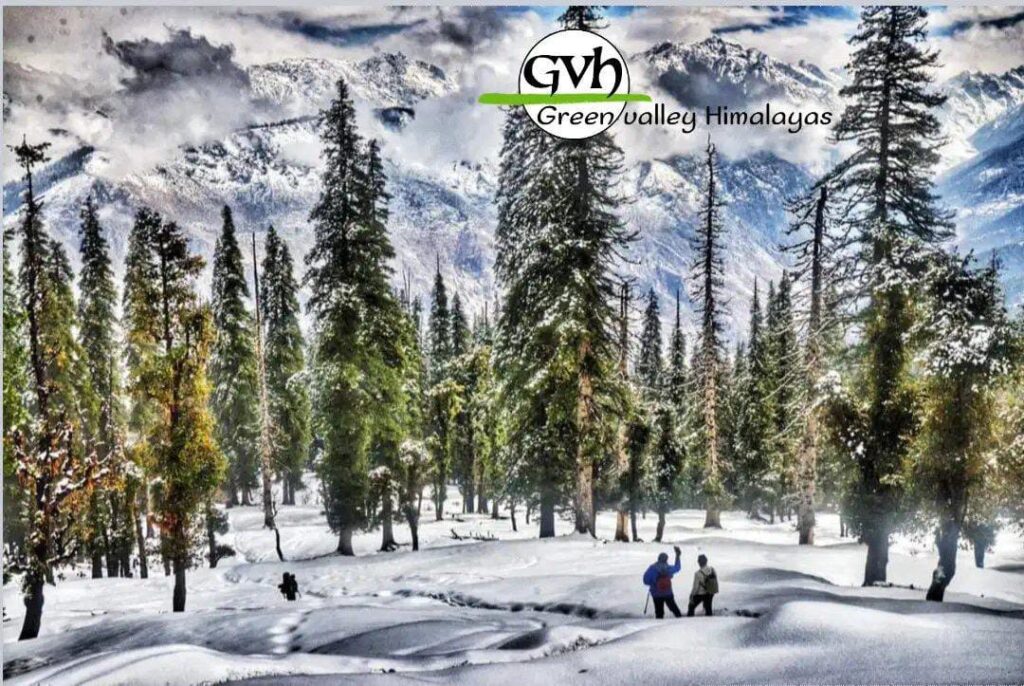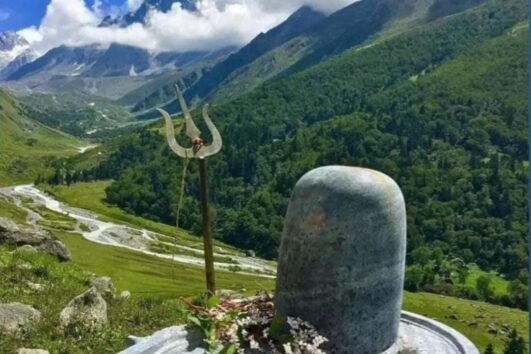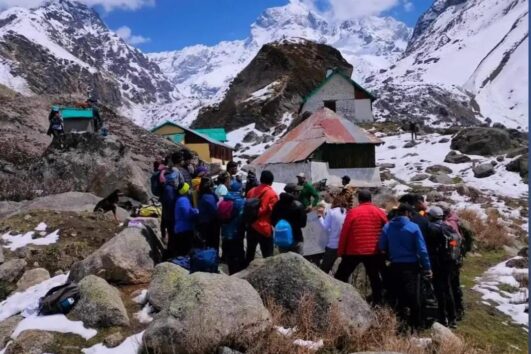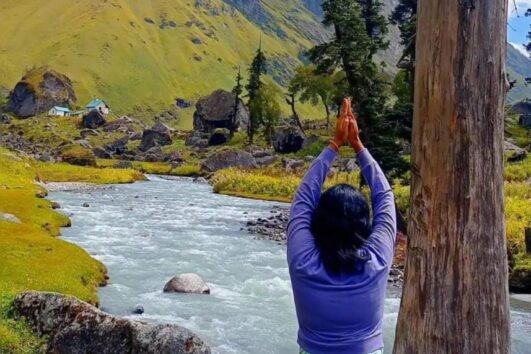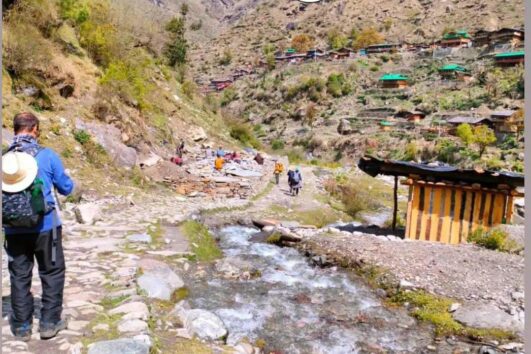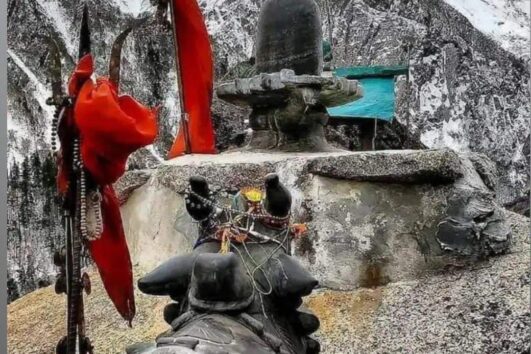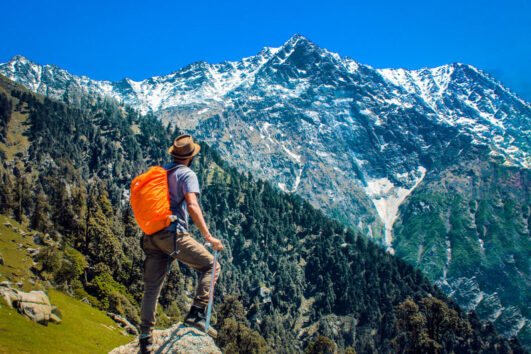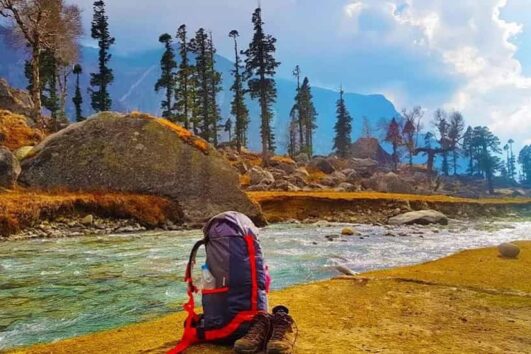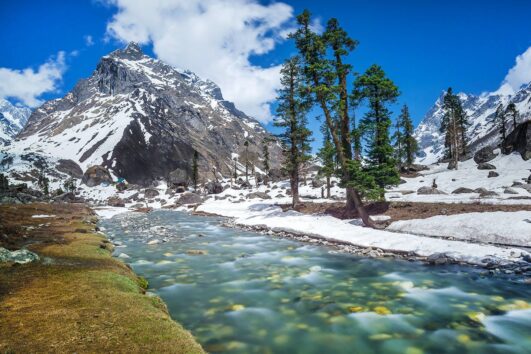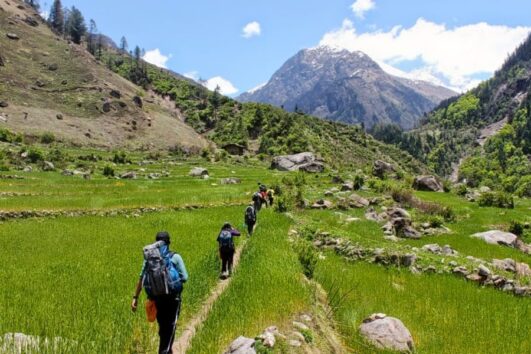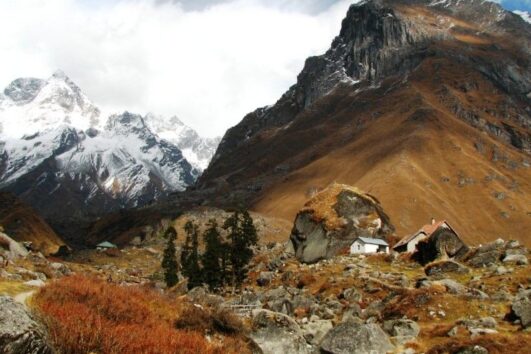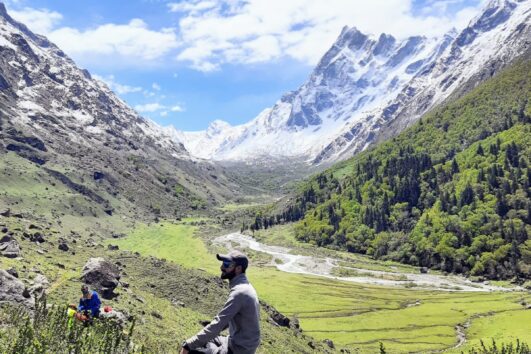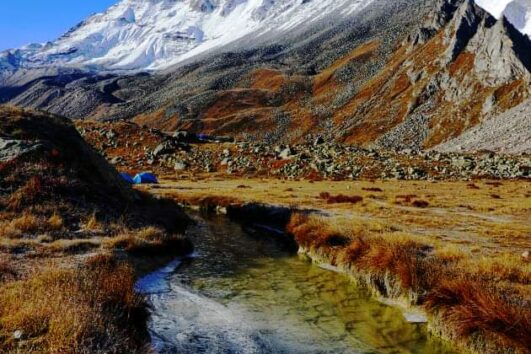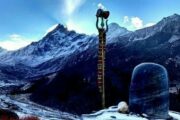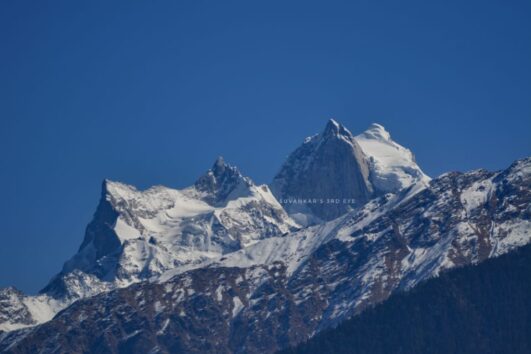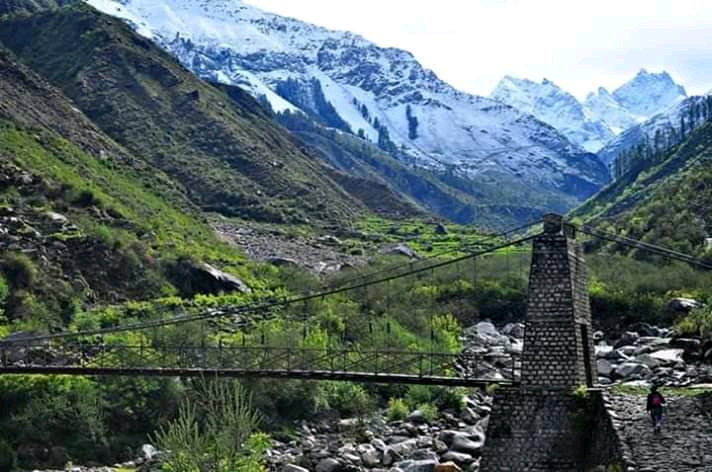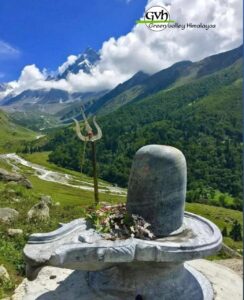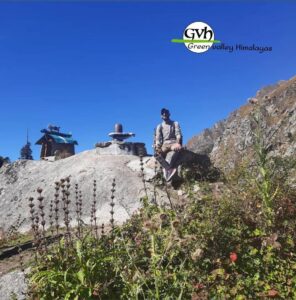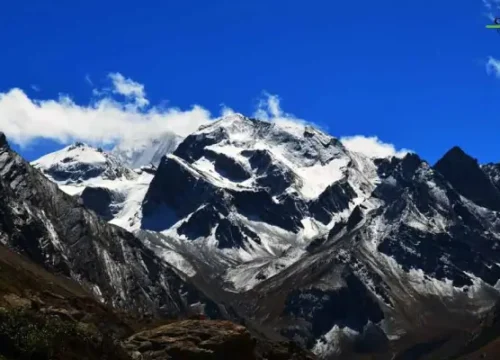Har Ki Dun Trek:
- Private/customised treks for your own group/family is open from
- March-: 5th, 10th, 12th, 16th, 18th, 19th, 21st, 28th
- April-: 1st, 6th, 12th,
- every saturday , sunday and coustmize batch 5th June, 15th June, 22nd june& Sep & Oct. is fixed departure .
- There will be 2nd OCT fixed Group departure trek to Har Ki Dun in autumn/summer.
TREK FEE: ₹ 10450 (Sankri to Sankri) + 5% GST
Cost Includes
- Book for 5 persons or more and get flat 10% Group Discount on TREK FEE
- Inclusions:
- 2 night’s accommodation at Sankri (Day 1 & Day 6) in lodge on twin sharing basis and dinner. Men and women will be given separate rooms in Fixed Departures.
- Car drop from Sankri to Taluka (trek starting point) and return.
- All meals during the trek (Day 1 dinner to Day 6 dinner). Regular Indian style nutritious vegetarian food during the trek (including occasional eggs), breakfast packed/hot lunch (depending upon the time you reach a campsite), snacks, dinner along with coffee/tea/soup.
- Excellent Trekking Guide, who will be a local to this particular area and has profound knowledge of the trekking trails around.
- Specialised Cook, Support staff, Porters/Packed Animals for carrying the central logistics of the trek.
- Stay in tents on twin sharing basis during the trek.
- Camping equipment like Sleeping bag, Carry mattress, Gaiters, Micro spikes/Crampon. (Bring your own sleeping if you have a high altitude specific personal Sleeping Bag. This is always better for hygienic reasons.)
- Kitchen tent, dinning tent and toilet tent as required during the trek.
- All permit fee, camping charges, forest levy required for the trek.
- Basic Medical & First Aid kit.
Cost Excludes
- Transportation from Dehradun to and back. ₹ 5500 for a Tata Sumo and ₹ 9000 for a Tempo Traveller. (₹ 1500- 2000 per person both ways for the pick up and drop when shared with fellow trekkers, payable directly to the driver.)
- We assume that you will carry your personal Rucksack/Backpack with all your personal belongings. If you want to offload your Rucksack and be carried by our Pack Animal/Porter then you need to pay additional ₹ 1500 for the entire duration of the trek. The Rucksack should not weigh more than 10 Kg.
- Anything which is NOT mentioned in the “Inclusions” or personal in nature.
HAR KI DUN TREK
- Private/customised treks for your own group/family is open from
- Sep-: 5th, 10th, 12th, 16th, 18th, 19th, 21st, 28th
- Oct-: 1st, 6th, 12th,
- every saturday , sunday and coustmize batch 5th June, 15th June, 22nd june& Sep & Oct. is fixed departure .
- There will be 2nd OCT fixed Group departure trek to Har Ki Dun in autumn/summer.
About the trek:
Har Ki Dun trek is probably the finest river valley trail in India, and never lost its charm to trekkers around the globe. There are many reasons for stating so, though the beauty of the valley in itself is the primary attraction. Change of colours in each season makes this route a year around choice for nature lovers.

Gentle hike through this wide fertile valley, remote villages enroute, culture and hospitality of the people you can’t miss. It is indeed a lovely walk to the Har Ki Dun valley with fascinating views of Jaundhar glacier and surrounding Swargarohini group of peaks. The views of Swargarohini group, Bandarpunch range and Black peak (Kalanag) are pretty descent to mention modestly. The walk culminates to a glacier carved spectacular valley, as if an amphitheatre ringed up by high spurs of rocky mountains. The sunrise and sunset at Har Ki Dun needs special mention.

Early snow during November and ample amount of residual snow during spring makes this trek a compelling choice. Further exploration towards Marinda Tal/Jaundar glacier will surely ignite the adrenaline in your adventurous mind.
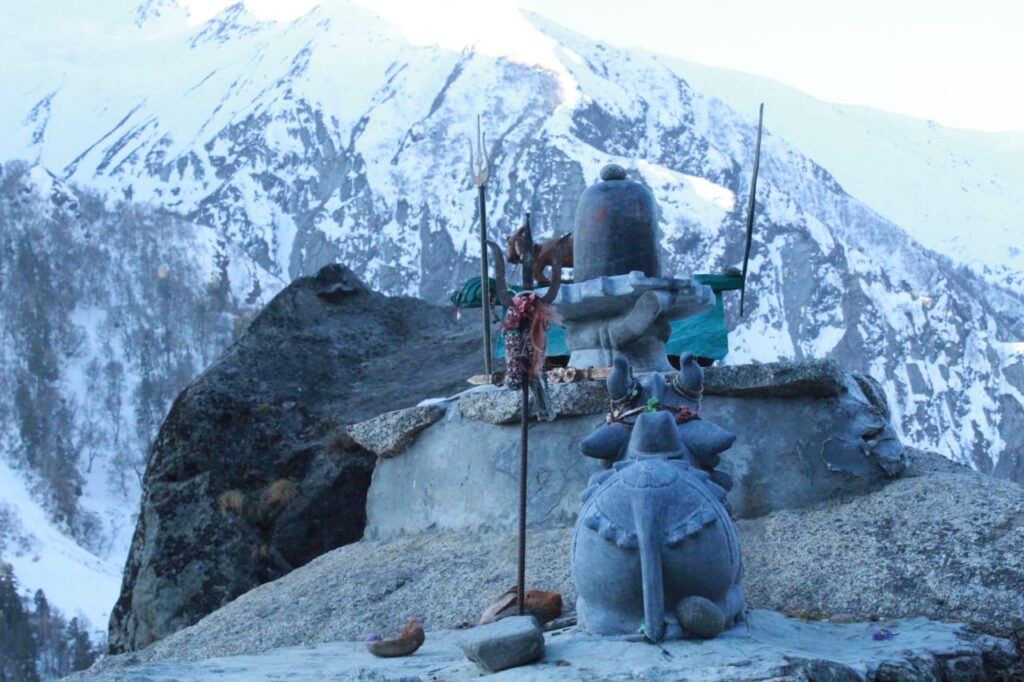
Due to the above facts, this trail is a must to visit for experienced hikers. The easy trail with gentle gradient makes it comfortable to beginners. No wonder that coupled with these two factors it is one of the most popular trek in Indian Himalayas.
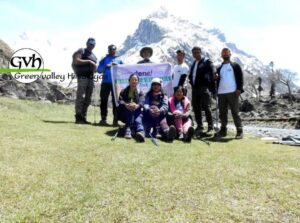
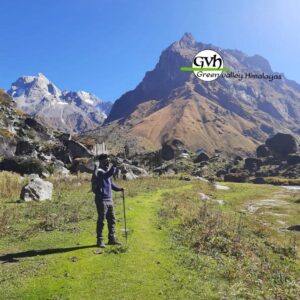
Brief Itinerary:
Day 1: Dehradun to Sankri – 200 Km by car – 9/10 hours. Lodge
Day 2: Sankri to Taluka – 11 Km by car – 1 hour – Trek from Taluka to Chilurgad via Gangar – 10 Km – 5 hours. Camp
Day 3: Trek to Simatra via Osla/Seema – 11 Km – 6 hours. Camp
Day 4: Trek to Har Ki Dun, Exploration around Har Ki Dun and return to Simatra – 12 Km – 7/8 hours. Camp
Day 5: Trek down to Chilurgad via Osla village – 5/6 hours. Camp
Day 6: Trek to Taluka – 10 Km – 4 hours, by car Sankri – 1 hour. Lodge.
Day 7: Drive to Dehradun – 200 Km – 9/10 hours.
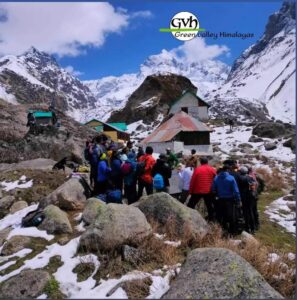
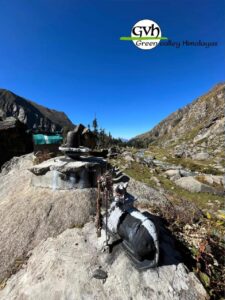
Important Note:
- You need to reach on your own to Dehradun on Day 1 morning (latest by 7 am) or the previous night. Return to Dehradun on Day 7 evening (by 7 pm). Arrange your tickets for inward journey and return from Dehradun accordingly. We will arrange transport to reach Sankri and return which is included in the TREK FEE.
- Last ATM is at Mori, 25 Km before Sankri but don’t depend till you reach here. Withdraw cash well in advance either in Dehradun, Naugaon or Purola.
- Only BSNL and Vodafone network may work at trek base Sankri, that too very limited connections. Make a phone call back to home from Mori while reaching Sankri. After Sankri there is no presence of network.
![]()
![]()
Location:
Har Ki Dun valley is on the far western flank of Garhwal in Uttarkashi district (Purola subdivision), Uttarakhand. The trek route lies entirely within the buffer and core region of Govind Pashu Vihar National Park. This catchment area is a major source of Yamuna through its largest tributary Tons river. To note, Har Ki Dun and Ruinsara Nallah form meandering Tamosa river, near Osla village. Tamosa flowing beside Taluka and below the village Sankri unites with Supin near Jakhol. Supin and Rupin combined at Netwar forms the Tons river.
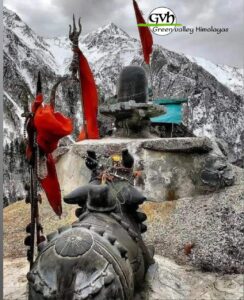
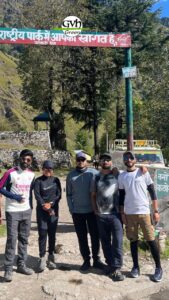
Camping ban at Har Ki Dun (Updated March 2019)
As per Uttarakhand High Court order ( Petition No. : 123/2014 ) , one can not camp on alpine and sub-alpine meadows/grasslands, locally called “Bugyal. Therefore forest department has revoked the permit to camp at Har Ki Dun effective from September’18. Starting from Oct’18, our highest camp is at Simatra after climbing Kalkatti Dhar. From Simatra we visit Har Ki Dun and return to camp for a day trip.

Best time to choose Har Ki Dun trek?
Har Ki Dun trail is truly an year around trek, apart from monsoon season of July/August when it not convenient to trek. Every season has something to offer, which is special on its own.
Note: As of 2019, Forest department is not issuing permit on this trail from December to February. Starting from December 2016, this is enforced considering the corridor of winter migration for wildlife overlapping the trail. At present no permit is given for winter Har Ki Dun trek from December to February.
As said above, this trek is still pretty beautiful in all the permitted seasons. If you are looking for snow, Spring (March/April) is ideal. Amount of residual snow depends on the actual snowfall during winter months though you can be sure to get some or ample amount of residual snow in spring. See more pictures of snow in 2019 update at the bottom of the page.
From May onward during the summer time, the valley turns into green, bright and luminous. Blue Pine, Deodar (Himalayan Cedar), Kharsu (Oak), Spruce, Silver Fir and Birch trees are lush and glossy green. Due to the heat glaciers melt faster and pour more water to the tributaries on Tons river. Day time temperatures are warm to pleasant and nights are cooler. If you don’t like cold atmosphere, certainly this is the season to choose.
After monsoon is over by end of August, the valley remains lush green throughout September. As the fall approaches, slowly the grass turns into pale yellow. Maple, Chestnut, Walnut and other deciduous tree species take the autumn leaf foliage. The surrounding transformed into spectacular yellow, orange and bronze hue. Not only foliage but an early snow fall chance during late autumn is another basis that you choose this season.
As you see, it is up to you to choose the best suitable time to trek in this beautiful valley. Its a beautiful route all around the year.
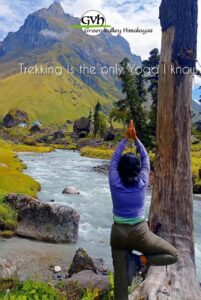
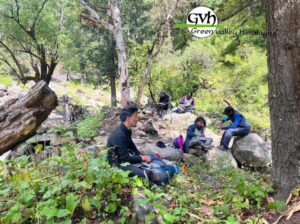
Interior villages, native people and culture during Har Ki Dun trek:
In recent days it is not common on Himalayas that you need to walk a full day to reach the last village on a trail from nearest motorable road. The trail starting from Taluka village extends the opportunity to see interior villages like Gangad, Powani and finally Osla. Neatly wooden crafted houses and dress of the local people resemble the neighbouring Kinnauri culture of Himachal Pradesh. Parents who are keen to initiate hiking and outdoor experience to kids on the Himalayas, this route is indeed a chart topper. If you are more keen on this type of interaction.
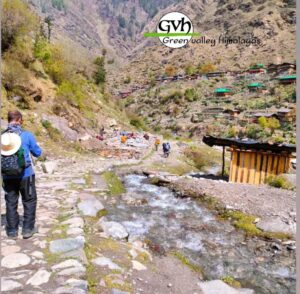
Osla temple and legends of Pandavas:
Starting in the 1980s some books/reports referred to the temple at Osla village as the “Duryodhana” temple. Even to date on most websites, it is portrayed that Mahabharata character Duryodhana is worshipped here. The proposition is indeed interesting but this may not be the case. This is a Someshwar temple and an adoration of Lord Shiva. To date, a festival along with a two week-long Mela (a village fair) is organised during monsoon in the month of Sawan worshipping the idol/Doli. The Doli moves from one village to another, seasonally.

Also, few websites point to the trail as the legendary path taken by the Pandavas to heaven. Swargarohini peaks don’t have any connection to the Swargarohini glacier, a.k.a Satopanth Swargarohini trek route which starts from Badrinath and is far away from this region.
Har Ki Dun trek temperature & clothing you need:
Summer (May/June): Daytime weather remains warm, especially if it is sunny and scorching and can go as high as 25/30°C. Night/early morning temp at Har Ki Dun can be around 10°C to 5°C.
Fall/Autumn (Oct/Nov) or Spring (Mar/Apr): From October temperature starts cooling down. At Har Ki Dun temperature can plummet to freezing in the night/early morning. Be prepared for 0°C. Expect similar temperatures if you trek during spring.
Winter (Dec/Feb): In Dec the daytime temp remains cool and nights are cold. Night temp at Sankri, Seema and Har Ki Dun can be around 2°, -2° and -5°/-10° C.
You need to be careful while selecting the proper clothing for this trek. Three layers of clothing is highly recommended.
a) A base layer – preferably a quick-dry t-shirt.
b) Mid layer – a warm jacket (Double layer or Fleece jacket ).
c) Outer layer – A windproof cum waterproof.

Access to Har Ki Dun trek base (Sankri):
We will arrange a pickup from Dehradun railway station to Sankri and back. This will be shared by the team members on an actual basis and paid directly to the driver. You pay directly to the driver/owner. The fare is ₹ 5500 for a Tata Sumo/Mahindra Maxx one way. This can accommodate 6 to 8 people. A Tempo Traveller charges ₹ 9000 (12-13 seats) one way. Comes around ₹ 1500- 2000 per person both ways for the pickup and drop when shared with fellow trekkers, payable directly to the driver. This is NOT included in TREK FEE.
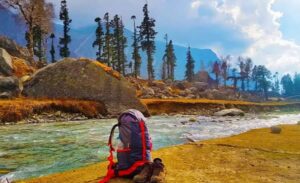
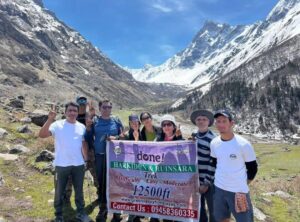
To reach the trek base Sankri independently or on public transportation, check the details in GETTING THERE TAB.
Updates from Har Ki Dun trek Spring/Summer, March to May 2019:
Finally, spring has arrived in the mountains. As you may know by this time, last winter was harsh, accompanied by consistent snowfall. This area is the westernmost part of Uttarakhand, bordering Himachal, and receives more snowfall than other similar routes. Frequent snowfall took place as late as the beginning of March. We hope that the trail will open by mid April, after some snow slogging and you will get residual snow at Har Ki Dun, as late as May.
Trip Highlights
- Duration: 5 days of trek; Walking to Har Ki Dun, exploration and return. Dehradun to Dehradun in 7 days.
- Prerequisite: Ideal first Himalayan trek with basic physical fitness.
- Grade: Easy
- Physicality: 5.5/10
- Trail Length: 50 Km
- Highest Point: Har Ki Dun valley ~ 3500 m/11500 ft.
- Seasons: March to June (snow) and September to November.
- Further Option: Continue to further north and cross Borasu Pass to reach Chitkul on Baspa valley in Kinnaur. (Difficult grade trek). Explore Jaundhar glacier (2 days side trip)
- Access: Trek starting point and end point is Sankri.
- Rail station: Dehradun (STN Code: DDN)
- Airport: Delhi; Jolly Grant in Dehradun (Airport Code: DED)

